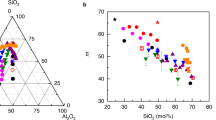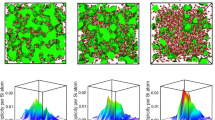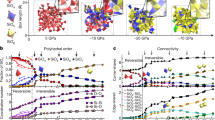Abstract
Liquid silica is the archetypal glass former, and compounds based on silica are ubiquitous as natural and man-made amorphous materials. Liquid silica is also the extreme case of a ‘strong’ liquid, in that the variation of viscosity with temperature closely follows the Arrhenius law as the liquid is cooled toward its glass transition temperature1,2. In contrast, most liquids are to some degree ‘fragile’, showing significantly faster increases in their viscosity as the glass transition temperature is approached. Recent studies3,4,5,6,35,36 have demonstrated the controlling influence of the potential energy hypersurface (or ‘energy landscape’) of the liquid on the transport properties near the glass transition. But the origin of strong liquid behaviour in terms of the energy landscape has not yet been resolved. Here we study the static and dynamic properties of liquid silica over a wide range of temperature and density using computer simulations. The results reveal a change in the energy landscape with decreasing temperature, which underlies a transition from a fragile liquid at high temperature to a strong liquid at low temperature. We also show that a specific heat anomaly is associated with this fragile-to-strong transition, and suggest that this anomaly is related to the polyamorphic behaviour of amorphous solid silica.
This is a preview of subscription content, access via your institution
Access options
Subscribe to this journal
Receive 51 print issues and online access
$199.00 per year
only $3.90 per issue
Buy this article
- Purchase on Springer Link
- Instant access to full article PDF
Prices may be subject to local taxes which are calculated during checkout




Similar content being viewed by others
References
Angell, C. A. Relaxation in liquids, polymers and plastic crystals—Strong/fragile patterns and problems. J. Non-Cryst. Solids 131–133, 13–31 (1991).
Richet, P. Viscosity and configurational entropy of silicate melts. Geochim. Cosmochim. Acta 48, 471–483 (1984).
Sciortino, F., Kob, W. & Tartaglia, P. Inherent structure entropy of supercooled liquids. Phys. Rev. Lett. 83, 3214–3217 (1999).
Buechner, S. & Heuer, A. The potential energy landscape of a model glass former: thermodynamics, anharmonicities, and finite size effects. Phys. Rev. E 60, 6507–6518 (1999).
Sastry, S. The relationship between fragility, configurational entropy and the potential energy landscape of glass-forming liquids. Nature 409, 164–167 (2001).
Martinez, L.-M. & Angell, C. A. A thermodynamic connection to the fragility of glass-forming liquids. Nature 410, 663–667 (2001).
Adam, G. & Gibbs, J. H. On the temperature dependence of cooperative relaxation properties in glass-forming liquids. J. Chem. Phys. 43, 139–146 (1965).
Stillinger, F. H. & Weber, T. A. Packing structures and transitions in liquids and solids. Science 225, 983–989 (1984).
Stillinger, F. H. A topographic view of supercooled liquids and glass formation. Science 267, 1935–1939 (1995).
Sciortino, F. & Tartaglia, P. Extension of the fluctuation-dissipation theorem to the physical aging of a model glass-forming liquid. Phys. Rev. Lett. 86, 107–111 (2001).
Starr, F. W., Sastry, S., La Nave, E., Scala, S., Stanley, H. E. & Sciortino, F. Thermodynamic and structural aspects of the potential energy surface of simulated water. Phys. Rev. E 63, 041201 (2001).
Rossler, E., Hess, K.-U. & Novikov, V. N. Universal representation of viscosity in glass forming liquids. J. Non-Cryst. Solids 223, 207–222 (1998).
Hess, K.-U., Dingwell, D. B. & Rossler, E. Parametrization of viscosity–temperature relations of aluminosilicate melts. Chem. Geol. 128, 155–163 (1996).
Barrat, J.-L., Badro, J. & Gillet, P. A strong to fragile transition in a model of liquid silica. Molecular Simulation 20, 17–25 (1997).
Horbach, J. & Kob, W. Static and dynamic properties of a viscous silica melt. Phys. Rev. B 60, 3169–3181 (1999).
Van Beest, B. W. H., Kramer, G. J. & van Santen, R. A. Force fields for silicas and aluminophosphates based on ab initio calculations. Phys. Rev. Lett. 64, 1955–1958 (1990).
Speedy, R. J. Relations between a liquid and its glasses. J. Phys. Chem. B 103, 4060–4065 (1999).
Hemmati, M., Moynihan, C. T. & Angell, C. A. Density maxima and minima, and water-like heat capacity and transport anomalies, in liquid BeF2. J. Chem. Phys. (in the press).
Angell, C. A. Water II is a strong liquid. J. Phys. Chem. 97, 6339–6341 (1993).
Speedy, R. J. The hard sphere glass transition. Mol. Phys. 95, 169–178 (1998).
Scala, A., Starr, F. W., La Nave, E., Sciortino, F. & Stanley, H. E. Configurational entropy and diffusivity of supercooled water. Nature 406, 166–169 (2000).
Johari, G. P. Contributions to the entropy of a glass and liquid, and the dielectric relaxation time. J. Chem. Phys. 112, 7518–7523 (2000).
Goldstein, M. Viscous liquids and the glass transition: sources of the excess heat capacity. J. Chem. Phys. 51, 3728–3739 (1969).
Coluzzi, B., Parisi, G. & Verrocchio, P. Thermodynamical liquid-glass transition in a Lennard-Jones binary mixture. Phys. Rev. Lett. 84, 306–309 (2000).
Bell, R. J. & Dean, P. The configurational entropy of vitreous silica in the random network theory. Phys. Chem. Glasses 9, 125–127 (1968).
Speedy, R. J. & Debenedetti, P. G. The distribution of tetravalent network glasses. Mol. Phys. 88, 1293–1316 (1996).
Stillinger, F. H., Debenedetti, P. G. & Sastry, S. Resolving vibrational and inherent structural contributions to isothermal compressibility. J. Chem. Phys. 109, 3983–3988 (1998).
Jagla, E. A. Fragile-strong transitions and polyamorphism in glass forming fluids. Mol. Phys. 99, 753–757 (2001).
Saika-Voivod, I., Sciortino, F. & Poole, P. H. Computer simulation of liquid silica: equation of state and liquid–liquid phase transition. Phys. Rev. E 63, 011202 (2001).
Sastry, S., Debenedetti, P. G., Sciortino, F. & Stanley, H. E. Singularity-free interpretation of the thermodynamics of supercooled water. Phys. Rev. E 63, 6144–6154 (1996).
Rebelo, L. P. N., Debenedetti, P. G. & Sastry, S. Singularity-free interpretation of the thermodynamics of supercooled water. II. Thermal and volumetric behavior. J. Chem. Phys. 109, 626–633 (1998).
Poole, P. H., Grande, T., Angell, C. A. & McMillan, P. F. Polymorphic phase transitions in liquids and glasses. Science 275, 322–323 (1997).
Mezei, M. & Beveridge, D. L. Free energy simulations. Ann. NY Acad. Sci. 482, 1–23 (1986).
Scheidler, P., Kob, W., Latz, A., Horbach, J. & Binder, K. Frequency-dependent specific heat of silica. Phys. Rev. B 63, 104204 (2001).
Sastry, S., Debenedetti, P. G. & Stillinger, F. H. Signatures of distinct dynamical regimes in the energy landscape of a glass-forming liquid. Nature 393, 554–557 (1998).
Debenedetti, P. G. & Stillinger, F. H. Supercooled liquids and the glass transition. Nature 410, 259–267 (2001).
Acknowledgements
We thank C. A. Angell, W. Kob, S. Sastry and R. Speedy for discussions. I.S.-V. and P.H.P. thank NSERC (Canada) for financial support, and SHARCNET for computing resources. F.S. acknowledges support from the INFM ‘Iniziativa Calcolo Parallelo’ and PRE-HOP and from MURST PRIN 2000.
Author information
Authors and Affiliations
Corresponding author
Rights and permissions
About this article
Cite this article
Saika-Voivod, I., Poole, P. & Sciortino, F. Fragile-to-strong transition and polyamorphism in the energy landscape of liquid silica. Nature 412, 514–517 (2001). https://doi.org/10.1038/35087524
Received:
Accepted:
Published:
Issue Date:
DOI: https://doi.org/10.1038/35087524
This article is cited by
-
Folded network and structural transition in molten tin
Nature Communications (2022)
-
Pressure-induced liquid-liquid transition in a family of ionic materials
Nature Communications (2022)
-
Structure Transformations and Supercooling in Nanostructured Gallium Alloys
Applied Magnetic Resonance (2022)
-
Experimental tests for a liquid-liquid critical point in water
Science China Physics, Mechanics & Astronomy (2020)
-
Concentrated suspensions of Brownian beads in water: dynamic heterogeneities through a simple experimental technique
Science China Physics, Mechanics & Astronomy (2019)
Comments
By submitting a comment you agree to abide by our Terms and Community Guidelines. If you find something abusive or that does not comply with our terms or guidelines please flag it as inappropriate.



